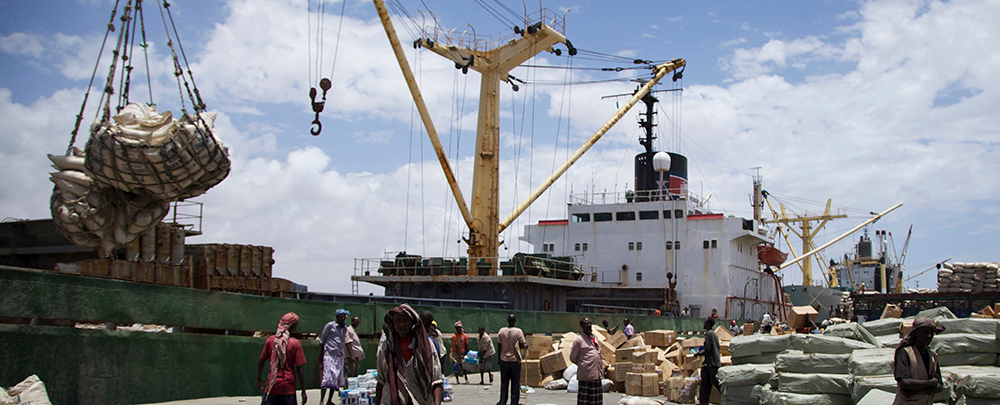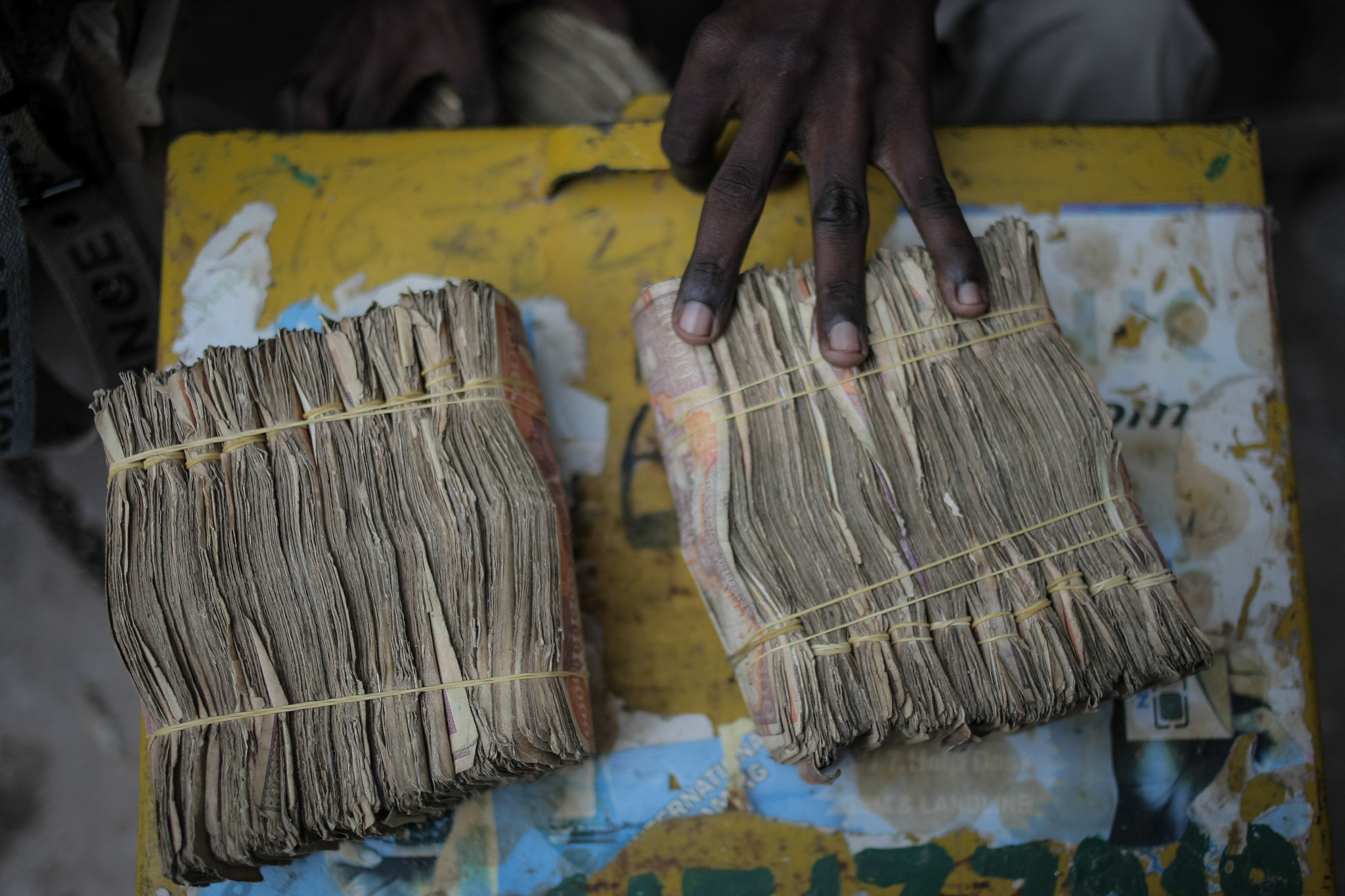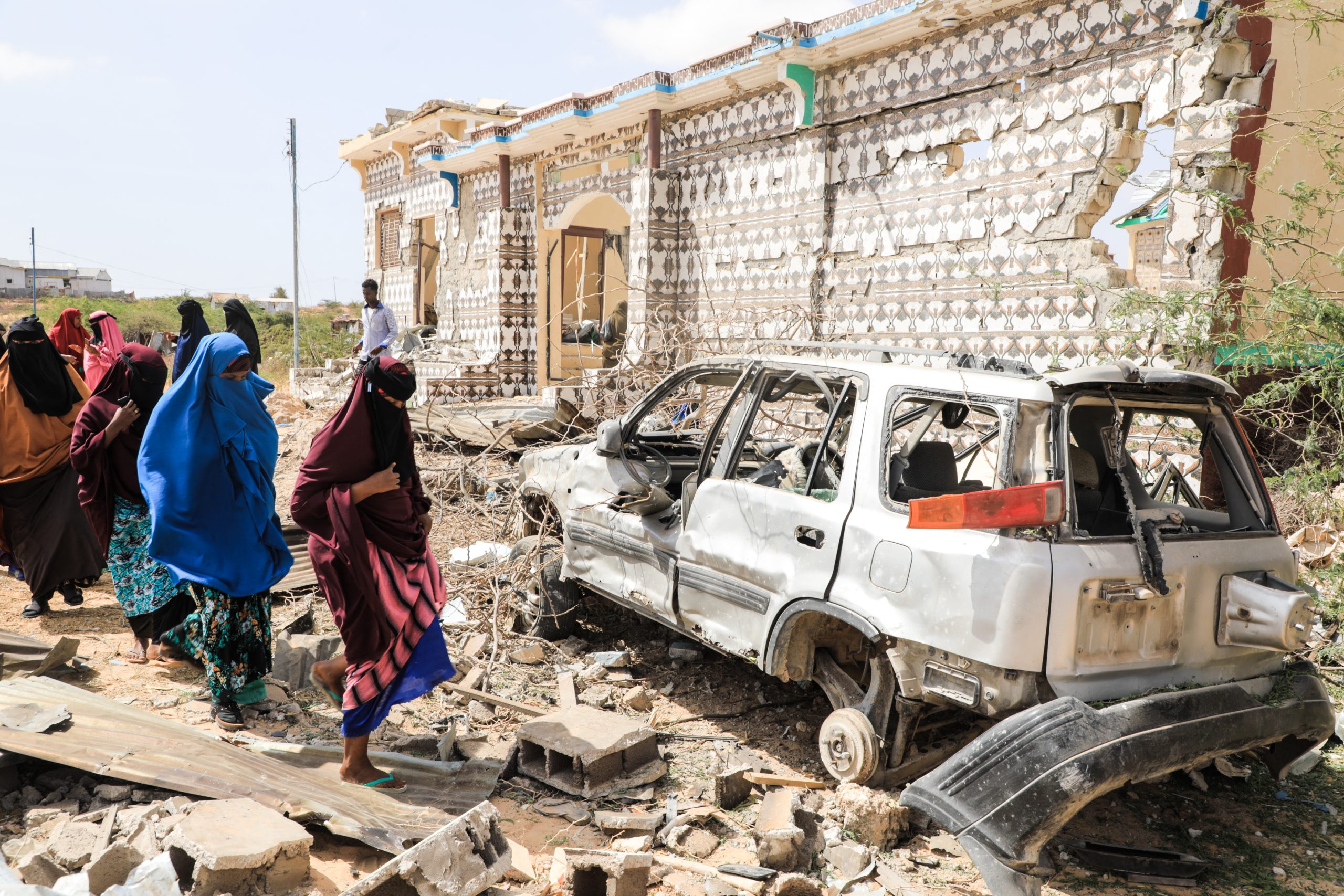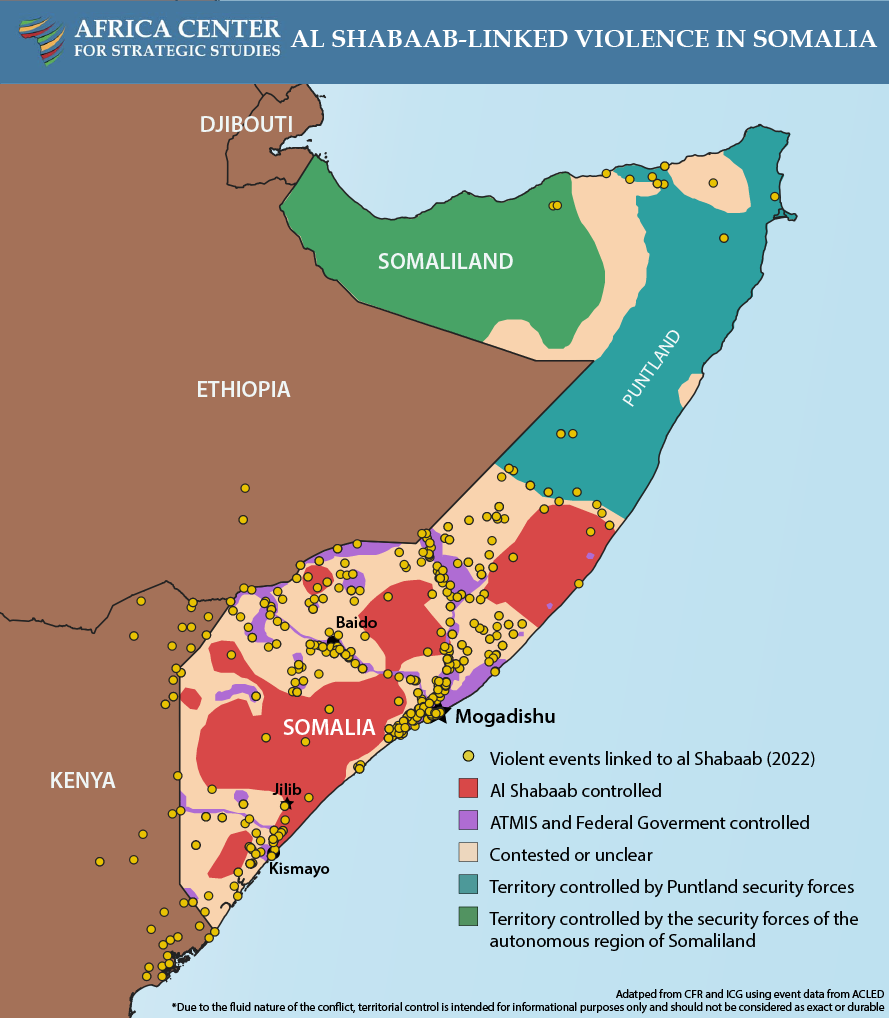
A cargo ship being unloaded in Mogadishu. Al Shabaab operates a system of extortion at ports of entry and roadways across Somalia. (Photo: Noe Falk Nielsen / NurPhoto via AFP)
Despite setbacks, al Shabaab remains a resilient and destabilizing threat in Somalia. In the past year, it was linked to 2,553 violent events and 6,225 fatalities. This represents nearly a doubling in the number of incidents since 2019. Fatalities involving al Shabaab have increased by 120 percent during this period.
A key means by which al Shabaab has remained resilient is the estimated $100 million in revenue it generates annually. By comparison, the Federal Government of Somalia accrues approximately $250 million in annual revenue.
Al Shabaab’s revenues support roughly 5,000 to 10,000 well-armed fighters as well as a network of operatives on the group’s payroll. Its revenues enable al Shabaab to sustain stable illicit regional supply channels while maintaining a phantom presence throughout much of Somalia.
Al Shabaab extorts revenue from various aspects of everyday Somali life—from toll roads to property taxes—building on its cultivated reputation of omnipresence and intimidation. Al Shabaab has also compromised various government agencies including, for example, acquiring freight manifests from port employees enabling it to extort shipping companies upon arrival.
“Al Shabaab extorts revenue from various aspects of everyday Somali life—from toll roads to property taxes—building on its cultivated reputation of omnipresence and intimidation.”
Al Shabaab has regularly conducted assassinations to enforce its will and silence opposition, targeting state governors, election delegates, government officials, and clan elders. Sheikhs who have publicly declared al Shabaab’s campaign un-Islamic have been singled out.
Al Shabaab’s revenues enable it to maintain a robust presence in media and information spaces to push its ideology, shape national and state politics, and spread disinformation. With such largesse, al Shabaab is well positioned to remain a destabilizing force in Somalia, the region, and further afield for years to come. Dismantling al Shabaab’s revenue generating infrastructure, therefore, is vital to undermining the capacity of the militant group.
How Does Al Shabaab Generate Revenue?
Al Shabaab has built a sophisticated criminal enterprise, compromising multiple levels of governance and coercing a wide variety of businesses and communities into compliance.
Al Shabaab has been honing a highly centralized system of extortion at ports of entry and roadways for nearly two decades, mostly in the territory it holds in the southern and south-central regions of the country. Its operatives maintain a registry of citizens’ assets for the purpose of collecting an annual 2.5 percent “zakat” tax. The zakat collection system is enforced by al Shabaab’s intelligence arm, the Amniyat, through systematic intimidation and violence. Traders who refuse to pay at checkpoints or community leaders who fail to comply with zakat demands are subject to assassination.
Al Shabaab generates revenue from 10 of Somalia’s 18 regions even though it may not retain a physical presence in all of them. The combination of intelligence and threat of violence allows al Shabaab to tap shipping imports and real estate transactions despite having no physical control over commercial hubs like Mogadishu and Bossaso.
Al Shabaab also invests a portion of its significant budgetary surplus in land and small- and medium-sized businesses in areas outside its control. In some regions, the group bombs or attacks the main travel routes forcing civilians to use the smaller roads on which al Shabaab maintains checkpoints.
What Makes Al Shabaab’s Revenue Generation So Successful?
Infiltration
Through cronyism and corruption, al Shabaab’s Amniyat has been able to consistently infiltrate the government, gaining the group sources of intelligence necessary to extort local authorities, businesses, and communities. Al Shabaab has been accused of having pressured clan elders to nominate sympathetic candidates to run for office, thereby giving it inside access to the National Assembly, Senate, and state legislatures.
The Amniyat has repeatedly infiltrated the National Intelligence and Security Agency (NISA). The Forum for National Parties, a conglomerate of six opposition parties went so far as to demand an overhaul of NISA in 2020. Some elements of Somalia’s national security forces have also been co-opted by al Shabaab, with as much as 30 percent of the Somali Police Force in Mogadishu believed to be compromised.
Al Shabaab has similarly gained influence within government agencies responsible for taxation and the Somali Chamber of Commerce and Industry.
Threat of Violence
Years of arms smuggling into the country, including via Puntland and Yemen, as well as accumulated materiel gained from attacks on military installations garnered al Shabaab a stockpile of increasingly sophisticated weaponry and components for IEDs. This steady supply of weapons ensures al Shabaab has a monopolization of violence in the areas under its control. In areas outside of its control, al Shabaab has undermined the perception of government capability by conducting numerous attacks on soft targets. During one such operation, operatives wore uniforms and identity cards from NISA. In another, the suicide bomber was an employee of the regional administration.

Security officers patrol the site of a car-bomb attack in Mogadishu. (Photo: Stringer / AFP)
Through these efforts of infiltration, co-option, and the use of violence, al Shabaab has effectively established the perception of omnipresence and intimidation typical of a mafia-like organization. As a result, its extortion scheme has touched virtually everyone—from the consumer purchasing goods or services to businesses who pay protection fees to al Shabaab and workers who pay al Shabaab a share of their income.
“In areas where al Shabaab has not been able to penetrate the locality to establish a threat of violence, its extortion practices are less successful.”
In areas where al Shabaab has not been able to penetrate the locality to establish a threat of violence, its extortion practices are less successful. Businessmen operating solely within Baidoa and Kismayo, for example, have reported rebuffing al Shabaab demands for payment without fear of retribution. This has coincided with periods in which AMISOM forces were stationed in these localities. Without its levers of omnipresence and intimidation, al Shabaab’s criminal enterprise is dramatically weakened—underscoring the necessity of having an uncompromised, population-centric security presence to impede al Shabaab’s tools of coercion.
Corruptible Institutions
Al Shabaab’s resilience is due, in part, to a government fraught with patronage and clannism, which exposes it to infiltration and sabotage.
In its own self-assessment, the Somali government noted “Corrupt government officials tolerate illegal activities in return for payments. Business is based on patronage networks, and tight monopolies dominate the market…. The governing elite are continuously involved in allegations of embezzlement of public funds from the already meagre Somali coffers, providing opportunities for rampant [money laundering].”
The prevalence of patronage in government and clan politics has contributed to the finding that despite years of international investment and training, “a significant portion of [Somali National Army] personnel deployed in the field have never received training and/or equipment from external partner programs or as part of the [federal member states] formation process.”
Such a dysfunctional environment makes it possible for an entity like al Shabaab to thrive.
Efforts to Disrupt Al Shabaab’s Revenue Streams
As al Shabaab’s extortion racket has grown, it has sought new ways to circulate and store its ill-gotten capital. One means of doing so has been through the formal banking and financial services that have been established in Somalia. To mitigate this, the government of Somalia implemented an Anti-Money-Laundering and Countering the Financing of Terrorism Act in 2016. The act requires financial institutions to report transactions that exceed $10,000.

The majority of financial transactions made between al Shabaab agents are still cash-based and through mobile money transfers. (Photo: Stuart Price / AU)
While this is an important first step, many money-transfer operators are afraid to report transfers that exceed $10,000 for fear of retaliation by al Shabaab. In 2019, only 9 suspicious transactions and 113 large cash transactions were reported from private financial institutions operating in Somalia.
The majority of financial transactions made between al Shabaab agents, meanwhile, are still cash-based and through mobile money transfers. There are an estimated 155 million mobile money transactions in Somalia a month, worth about $2.7 billion. The UN has found that a lack of mobile money and “know your customer” regulations has resulted in anonymity of mobile account holders, a gap al Shabaab has repeatedly exploited. In its effort to implement a more robust regulatory framework, the federal government developed mobile money regulations and, in February 2021, licensed its first mobile money service provider. Since then, two more providers have been licensed and the government expects their full compliance with regulations toward the end of 2023.
The UN Office on Drugs and Crime has provided the government of Somalia technical support on disrupting al Shabaab’s financing sources, methods of storage and transfer, and illegal taxation systems. However, the federal government has been slow to curb al Shabaab’s exploitation of the financial system beyond targeting al Shabaab financial officers and “taxation” checkpoints via conventional military operations.
Lessons from Other Countries’ Efforts to Dismantle Mafia-Like Organizations
Experiences from other countries’ efforts to control money laundering may hold lessons for Somalia.
In Libya, a call-in radio program in the city of Zuwara educated listeners on the harmful impact of organized crime and how law enforcement, civil society, and religious leaders could join forces to counter it. The initiative raised awareness and generated a positive response from the public.
In some cases, the level of mafia power and political negligence are so overwhelming that a dissolution of the local authority is necessary. This is something that happened to the city council of Reggio Calabria in Italy in 2012, providing an opportunity for a reset toward impartiality and good governance of the local administration.
As recognized in Italy, asset confiscation has been a powerful instrument against the mafia. Turning seized assets (i.e., property, businesses) over to citizen-run collectives for economic development to benefit that community helps build public support against the criminal network.
In the western Balkans, social reuse of confiscated criminal assets has similarly opened the possibility of strengthening resilience to organized crime and building bridges between civil society and the authorities.
Dismantling Al Shabaab’s Criminal Empire
Al Shabaab has been effective at generating revenue by co-opting key government and financial entities in Somalia. The government continues to suffer from several self-identified vulnerabilities, not least the lack of proper identification, a lack of coordination among regulatory, law enforcement, and judicial authorities, and a lack of political will. An essential next step in countering Al Shabaab’s revenue flows, therefore, is to further prioritize the professionalization of the government’s infiltrated agencies, particularly the entities responsible for financial, intelligence, and judicial functions, which are at the forefront of shutting down al Shabaab’s financing and money laundering.

Women walk next to wreckage from an al Shabaab attack on a police station in Mogadishu. (Photo Hassan Ali Elmi / AFP)
This will require more than just financial sector development but also better criminal investigatory work, improved law enforcement, and a change in culture within the federal government and federal members states toward transparency, accountability, and citizen service delivery.
“Restricting al Shabaab’s revenue flows is simultaneously tied to strengthening Somalia’s population-centric counter insurgency efforts.”
Al Shabaab’s capacity for extortion leverages its reputation of omnipresence and intimidation. As the examples of Baidoa and Kismayo reveal, however, the presence of a capable and disciplined security force that is free from al Shabaab influence can undermine that perception and reestablish space for the government, the private sector, and civil society (including religious leaders) to operate autonomously. Restricting al Shabaab’s revenue flows, therefore, is simultaneously tied to strengthening Somalia’s population-centric counter insurgency efforts.
Experience from other parts of the world dealing with mafia-like influence shows that these patterns can be reversed. However, this will require sustained political will as well as incentives and protections to engender popular cooperation with the government against al Shabaab’s expansive revenue generation schemes.
Additional Resources
- Paul D. Williams and Afyare Elmi, “Security Sector Reform in Somalia: Challenges and Opportunities,” Heritage Institute, January 2023.
- National Risk Assessment on Money Laundering and Terrorist Financing, Federal Government of Somalia Financial Reporting Center, 2022.
- Jay Bahadur, “Terror and Taxes: Inside al-Shabaab’s revenue-collection machine,” Global Initiative Against Transnational Organized Crime, December 8, 2022.
- United Nations Security Council, Report of the Panel of Experts on Somalia submitted in accordance with 2607 (2021), S/2022/754 (October 10, 2022).
- Catherine Lena Kelly, “The Impact of the Rule of Law on National Security in African Countries,” Judicature International, February 2022.
- Stig Jarle Hansen, “Into Darkness? Scrutinizing Economic Explanations for African Jihad,” Hudson Institute, October 27, 2021.


